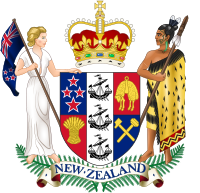2012 New Zealand Budget
 |
|
| Submitted by | Bill English |
|---|---|
| Parliament | Parliament of New Zealand |
| Party | National |
| Total revenue |
|
| Total expenditures |
|
| Deficit |
|
| Debt |
|
|
‹ 2011
2013 ›
|
|
The New Zealand budget for fiscal year 2012–2013 was presented to the New Zealand House of Representatives by Finance Minister Bill English on 24 May 2012.
This was the fourth budget Bill English has presented as Minister of Finance.
Budget 2012 set out the Government's main priorities:
The Budget set out $4.4 billion of new operating spending over the succeeding four years matched by a combination of savings and revenue initiatives.
Budget forecasts show an operating deficit before gains and losses of $8.4 billion in 2011/12, which compares with the $12.1 billion deficit forecast in the Budget Policy Statement in February 2012. This reflects lower-than-expected government spending and a delay in some expenses, such as earthquake costs.
The Budget forecast the deficit falling to $7.9 billion in 2012/13 and $2 billion in 2013/14, before a $197 million surplus in 2014/15.
The forecasts also showed Budget decisions will keep net core Crown debt below 30% of Gross Domestic Product. It forecast a peak at 28.7% of GDP in 2013/14.
Budget forecasts also showed economic growth picking up from 2% in 2012 to more than 3% in 2014 and 2015.
The Treasury forecast a further 154,000 New Zealanders to gain work over the next four years, on top of the 60,000 increase in employment over the past two years.
The Government's annual spending on science and innovation increased by $385 million over four years, taking total science and innovation spending across government to more than $1.3 billion by 2015/16.
Free "Youth Guarantee" places increased to 3,000 at a cost of $37.7 million over four years.
The Government established the Future Investment Fund to invest the expected $5 billion to $7 billion proceeds from selling minority shares in five state-owned enterprises, into modern schools and hospitals, innovation, and transport.
The fund's first $558.8 million allocation is:
In addition to the previously announced target of having 85% of 18-year-olds achieving NCEA Level 2 or equivalent qualification in five years, the Budget added two more measurable targets for the next three to five years:
In the first phase of welfare reform, Budget 2012 invests $287.5 million on education and training. This includes $148.8 million over four years for youth services, including wrap-around support.
...
Wikipedia
